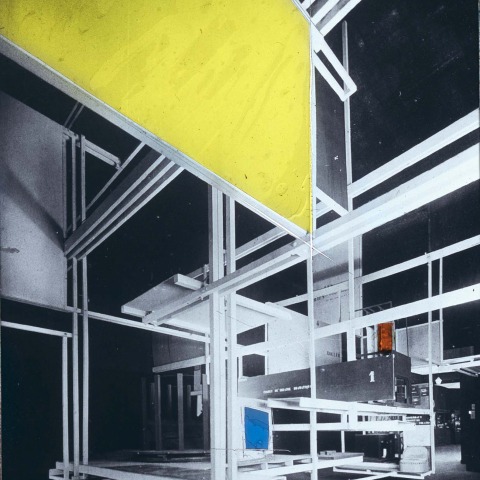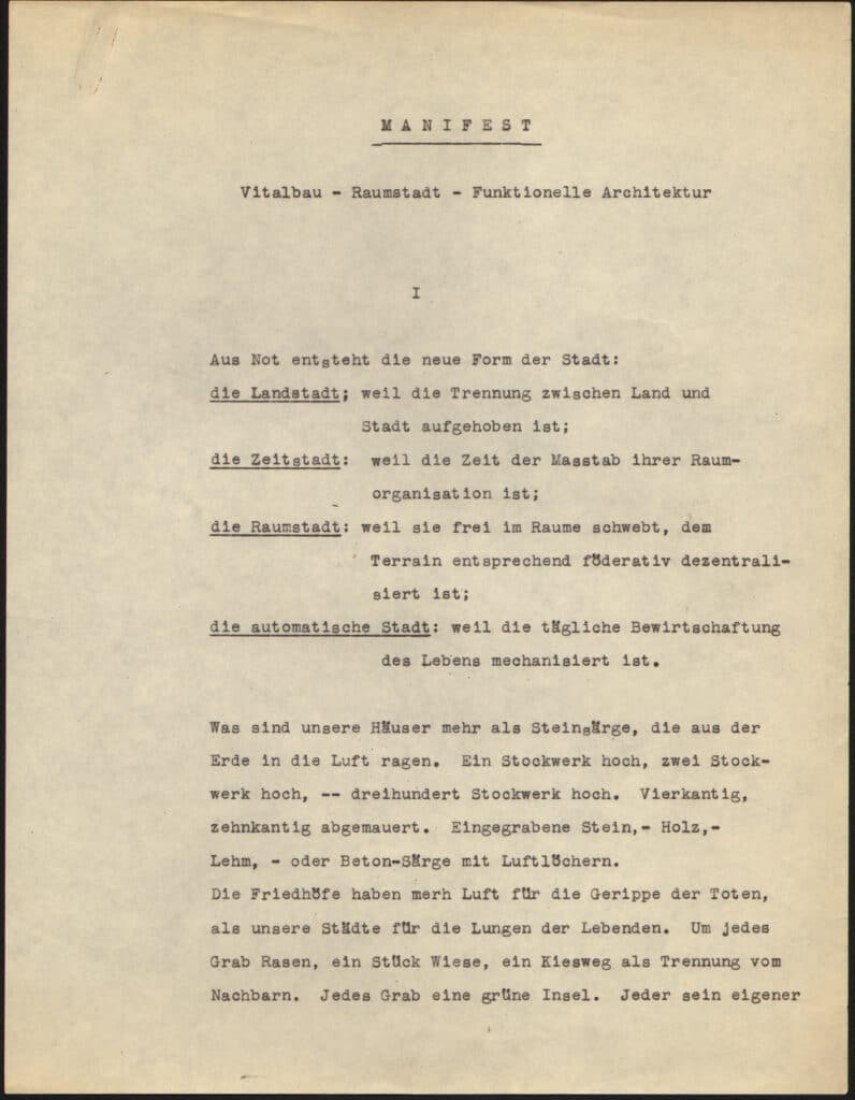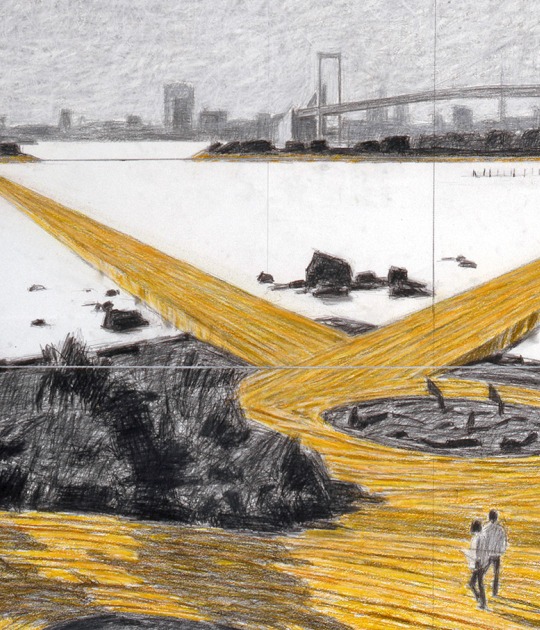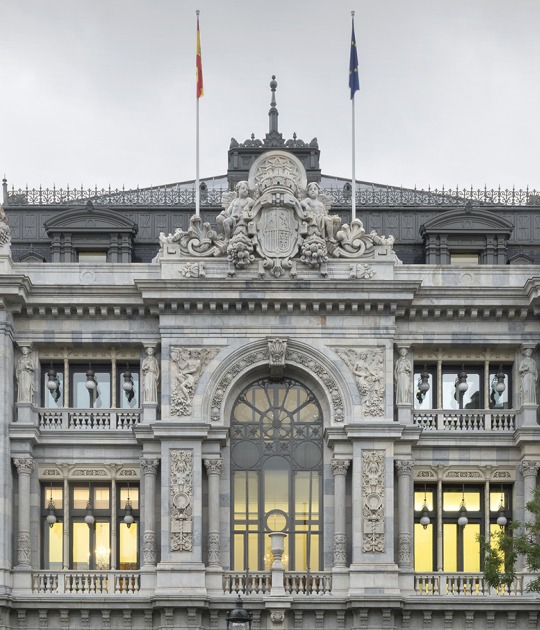The focus of the presentation is the Manifesto of Tensionism. Organic Building – the City in Space – Functional Architecture, which pursues the idea of a city of the future that floats freely in space. First shown by Frederick Kiesler at the Exposition Internationale des Arts Décoratifs et Industriels Modernes in Paris in 1925, this was regarded at the time as one of the most radical architectural concepts to have ever been presented to the public.
Alongside the manifesto, the exhibition will also present photographs, a model and audio elements. An accompanying program with discussions of the exhibition is also in preparation, as is a publication with photographs, the manifesto and further bibliographic references.
Paris 1925: Frederick Kiesler is invited by Josef Hoffmann to design the section on Austrian theater at the Exposition Internationale des Arts D coratifs et Industriels Modernes. However, he merely uses the exhibition architecture as a pretext for developing a monumental abstract geometrical sculpture that is suspended from the ceiling. Alongside its actual function as a support for the items in the exhibition, he principally employs this as a model-like visualisation of his idea of a freely-floating city of the future, which he propagates, with great medial extravagance, as the City in Space.
Alongside Konstantin Melnikov’s Soviet Pavilion and Le Corbusier and Pierre Jeanneret’s Pavillon de l’Esprit Nouveau, the City in Space is one of the most radical architectural concepts of the Paris exhibition. Even at the time it attracts considerable attention in the international art and architecture scene and rapidly develops into a 20th-century architectural icon.
Kiesler outdoes the radicalism of the model-like realisation in the exhibition space in Manifesto of Tensionism. Organic Building – the City in Space – Functional Architecture, which he releases in two of the leading avant-garde magazines, De Stijl and G, which are published by Theo van Doesburg in the Netherlands and Hans Richter in Berlin, respectively.
Manifesto of Tensionism.
Organic Building—the City in Space—Functional Architecture
Paris, 19 April 1925
F. KIESLER
Compulsion directs the new form of the city:
The Country-City: the division of city from country will be abolished.
The Time-City: time is the measure of the organization of its space.
The Space-City: it floats freely in space in a decentralized federation
dictated by the ground-formation.
The Automatic-City: the processes of daily life are mechanized.
What are our houses but coffins towering up from the earth into the air? One story, two storys – a thousand storys. Walled up on two sides, on ten sides. Stone entombed – or wood, clay, concrete. Coffins with airholes.
Cemeteries have more air for the skeletons of their dead than our cities for the lungs of their living. Each grave has its lawn, its piece of meadow, a gravelled path to separate it from its neighbors. Each grave an islet of green. Each his own master: each his own settlement. [Homesteaders, let this be an example to you!]
And our cities?
Walls, walls, walls …
We will have no more walls, these armories for body and soul, this whole armorized
civilization; with or without ornament. We want:
1. Transformation of the surrounding area of space into cities
2. Liberation from the ground, abolition of the static axis
3. No walls, no foundations
4. A system of spans (tension) in free space
5. Creation of new kinds of living, and, through them, the demands which will remould society.
Have we found a good piece of carrion? That we remain glued to one place and there and only there sink in our teeth [, and seek and seek]; on the exact spot where this city of London, New York, Paris … is built? That we must pile on top of one another; and be afraid; and sit on one another’s neck.
Are these YOUR questions? Whether or not the walls have ornaments? A fig for such questions! Leave out the walls, ye founders and venal copy-cats, draw in fresh air through YOUR own pores – and such a question exists no longer! Butt YOUR heads against empty space! We must have something to laugh about!
We are satiated with architecture. We want no new editions, be they ever so well contrived. Instead of the old bedizzened single-faced models, plain four-faced models; for baroque curves, straight lines; for ogival windows, rectangular windows. The expert is bankrupt. What interests everyone is: how does one live among these curved or straight walls; from what sort of life, of new life, do these four or x faces arise?
Instead of ornament, plain walls; instead of art, architecture – these are your demands. But we must have organic building; the city in space; functional architecture.
Elasticity of building adequate to the elasticity of living.
It is irrelevant whether cupolas or cubes dome man. Either way he suffocates. And your windows do nothing to free him.
One must discover the urge of the age, as electricity was discovered. One must invent new life, as the motor was invented. Until then this life is merely a process of physical digestion.
The new city will bring with it the solution of the problems of traffic and hygiene; make possible the diversity of private life and the freedom of the masses. It is not built to suffice in itself, but, by the strictest economy of means, to create the greatest possible abundance.
There will exist no longer houses doming man, which shout at him: “Sleep well, eat well, and take a gasp of air now and then.” And with the disappearance of houses conceived in this spirit, the streets of huddled cubes will be resolved into free living and working areas.
You have always misunderstood:
The ringmaster of a new style hold out a circle before your noses and – hoopla! You jumped through it. Just now it is a rectangle. Tomorrow???
Take care that the jade you are riding does not bolt under you, and pitch on these inquisitive noses into the muck.






















![Frederick (then Friedrich) Kiesler's City of Space [Raumstadt] debuted at the Exposition des Arts Décoratifs in Paris, 1925 Frederick (then Friedrich) Kiesler's City of Space [Raumstadt] debuted at the Exposition des Arts Décoratifs in Paris, 1925](/sites/default/files/styles/mopis_home_news_category_slider_desktop/public/images-lead/G.jpg?h=5c5ad3f7&itok=2bsigA7w)





